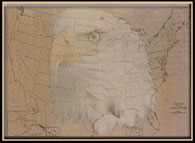|
Background/History of the Survey
Each January, several hundred individuals count eagles along standard,
non-overlapping survey routes as part of a nationwide Midwinter Bald
Eagle survey .
Nationwide counts of eagles were coordinated by the National Wildlife
Federation from 1979 until 1992, when the Bureau of Land Management's
Raptor Research and Technical Assistance Center assumed responsibility
for overseeing the count. Responsibility for count coordination
shifted to the National Biological Survey (1993-1996) and later to the
U.S. Geological Survey (USGS), Forest and Rangeland Ecosystem Science
Center, Snake River Field Station. In April 2007, the USGS
established a partnership with the U.S. Army Corps of Engineers (USACE)
to maintain the long-term, national coordination of the survey, data
analysis, and reporting. USACE will assume responsibility for
coordinating the national survey, organizing the results, maintaining
the long-term database, and jointly compiling, analyzing, and reporting
survey data gathered with USGS following previously used methods
(Steenhof et al. 2002) in 2010 and 2015.
Initial objectives of the survey were to establish an index to the
total wintering Bald Eagle population in the lower 48 states, to
determine eagle distribution during a standardized survey period, and
to identify previously unrecognized areas of important winter habitat.
In 1986, Millsap (Wildl. Soc. Bull. 14:433-440) reported results of the
midwinter survey from 1979 through 1986. Beginning in 1984, National
Wildlife Federation officials asked participants in each state to count
eagles along standard routes to provide data on count trends. Standard
survey routes were defined as clearly described areas where eagles had
been observed in the past. Federation guidelines stipulated that
standard surveys be conducted by the same number of experienced
observers using the same method (e.g., fixed-wing, helicopter, boat,
vehicle) at approximately the same time of day each year.
Observers conduct surveys on standard routes during the first 2 weeks
of January each year, usually on 1 of 2 target days. Most survey
participants are employees of state or federal conservation agencies,
but private volunteers also participate in the survey. Coordinators
from each state are responsible for organizing local counts, enlisting
survey participants, and compiling data to eliminate duplicate
sightings and overlapping routes. Sizes of survey routes vary from
single fixed points to 150 miles. Approximately 44% of the surveys are
conducted from vehicles. 18% are conducted from fixed wing aircraft; 8%
are collected from boats; and 7% are conducted by helicopter. Due to
weather and staffing limitations, not all standard routes are surveyed
every year. Twenty-five states identified and began surveying standard
routes in 1986; other states did not begin standard surveys until the
mid-1990s. Some states stopped participating in the count in the 1990s.
The number of states participating each year has ranged from 25 to 41,
and the number of standard survey routes per state ranges from 1 to 84.
This web site reports results of an evaluation of data from 1986-2005.
The analysis was based on 178,896 observations of eagles during 8,674
surveys of 746 routes in 43 states. Trends were estimated according
to procedures outlined by Steenhof et al. (2002): Steenhof, K.,
L. Bond, K.K. Bates and L.L. Leppert. 2002. Trends in midwinter counts
of Bald eagles in the contiguous United States, 1986-2000. Bird
Populations 6:21-32.(
see full text here).
As a large-scale volunteer effort that developed over many years, the
Midwinter Bald Eagle survey has inherent problems. Many reports we
received could not be used because of incomplete documentation or
inconsistent survey methods. Because survey routes were not randomly
selected, we do not know if the standard routes used in this analysis
are representative of the contiguous 48 states. Our findings are likely
biased towards states and portions of states where agencies and
individuals were committed to long-term, consistent data collection. We
have assumed that winter counts are a reasonable index to eagle
abundance at the areas surveyed during the January sampling period.
Trend analyses based on counts as indexes are valid only if the
proportion of the population sampled is constant from year to year. The
ability to detect eagles on survey routes may vary with many factors,
including weather, topography, and vegetation, and we are assuming that
errors in detectability are consistent from year to year on a given
survey route. We have controlled for variation in detectability by
including only those surveys that covered the same area, using the same
transportation method each year. Varying ability of individuals to
detect and identify bald eagles is likely not as much of a problem in
midwinter eagle surveys as it is in Breeding Bird Surveys and other
singing-bird surveys. The annual midwinter survey represents a unique
source of long-term, baseline data. Unlike nesting surveys, it provides
information on both breeding and nonbreeding segments of the population
at a potentially limiting time of year. It also provides an opportunity
to monitor modifications or threats to habitat at important wintering
areas. The count has become a tradition that will likely continue in
many states. In addition to providing information on eagle trends,
distribution, and habitat, the count has helped to create public
interest in Bald Eagles and their conservation.
|
|




